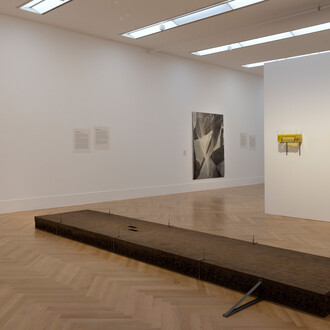The Surreal in Indian Painting: Select Works from the Arturo Schwarz and other Private Collections, an exhibition of twenty-four paintings dating from the 17th to the 19th century, will be staged by Prahlad Bubbar at his gallery at 33 Cork Street, London, from 4 October to 15 November 2013. The exhibition is timed to coincide with Islamic Art Week and Asian Art in London.
Surrealism in the West was launched by André Breton with his first Manifeste du surréalisme published in 1924 although the term surréalism had been coined by the French poet and art critic Guillaume Apollinaire in 1917. The central idea of the movement was to release the creative powers of the unconscious mind and surrealist works are characterised by fantastic imagery and incongruous juxtaposition of subject matter. For Arturo Schwarz (b. 1924), the Italian art historian, writer, curator and committed Surrealist, Surrealism is not just an artistic movement but a philosophy of life. It also informed his approach to collecting: half of the works in this exhibition formerly belonged to him.
Schwarz is best known for his writings about Marcel Duchamp, the Surrealists and Dada as well as books and essays on Kabbalah, Tantra, prehistoric and tribal art, Asian art and philosophy. He amassed a vast collection of Surrealist and Dada art including many works by personal friends such as Marcel Duchamp, André Breton, Man Ray and Jean Arp, a large portion of which he has donated to the Israel Museum in Jerusalem. In the 1960s, Schwarz travelled to India where he was deeply taken with the mythology and its imagery, inspiring him to write books on the subject and to collect Indian paintings and sculpture which he mainly acquired in Paris and New York. He was drawn to the unusual iconography, esoteric subject matter and works with a dreamlike quality.
Growing up in Florence, Prahlad Bubbar was also attracted to the art of the Surrealists. One of the first exhibitions he attended was I Surrealisti staged in Milan in 1989 and curated by Arturo Schwarz. The two men met in 2007 and Bubbar was introduced to Schwarz’s collection of Indian miniatures. This exhibition stems from their friendship and mutual interests.
Indian art regularly inhabits realms of the ‘unconscious’ exploring fantasy, myth and mystical themes. A Fantastical Elephant Driven by Demons Past a Waq-Waq Tree, a brush drawing of a composite elephant dating to around 1625, is a masterpiece of early 17th century draughtsmanship by an Imperial artist working at the Islamic courts of the Deccan or Mughal Empire. While it is an exuberant display of artistic virtuosity, it also has mystical undertones, illustrating a belief in the divine unity of all living beings. The vibrantly coloured A Composite Ram from Kota, Rajasthan, circa 1750, sees this tradition played out in a Hindu context, while Lovers in Union, a painting on cloth from 18th century Orissa, invokes the theme once more, their erotic coupling a metaphor for union with the divine.
The exhibition also features significant works from the Tantric traditions of India and Nepal. Tantra is a complex concept with many facets, but it can broadly be defined as referring to practices based on a group of historic texts called ‘Tantras’, which emphasise specific rituals, secrecy and the importance of the teacher (guru) in the pursuit of spiritual gain. A folded manuscript from 18th century Nepal, The Chakras of the Subtle Body, is a manifestation of the seven ‘chakras’, or internal centres of energy, within the ‘spiritual’ body. The painting is over three metres long and accompanies a Hindu text that outlines specific mantras (sounds or words to aid meditation).
The Yantra of the Goddess Bagalamukhi, one of the ten goddesses of great wisdom – the yantra being her Tantric geometric symbol, painted in Guler, Punjab Hills, circa 1800-20, is a rare example of a Tantric diagram of courtly patronage. Chinnamasta, the self-decapitated tantric goddess, also from a Guler workshop circa 1800-20, conveys the full power and intensity of Tantric imagery through the lyricism of one of India’s most celebrated painting schools.
Other attractive works include Indra Rides His Elephant Airavata, a painting of the king of the gods from the Pahari Hills, circa 1825, and a folio from a Ragamala Series (garland of musical melodies) from Hyderabad, circa 1760.
The Surreal in Indian Painting will be accompanied by a catalogue featuring essays by Arturo Schwarz, previously unpublished in English. It will undoubtedly throw new light on esoteric themes in Indian painting appeal not only to collectors of Indian miniatures but also to lovers of Indian religion, philosophy and European surrealism.
Prahlad Bubbar Gallery
33 Cork Street
London W1S 3NQ United Kingdom
Ph. +44 (0)20 74943144
info@prahladbubbar.com
www.prahladbubbar.com
Opening hours
Monday to Friday
From 10am to 5pm
Related images
- Indra Rides His Elephant Airavata, Punjab Hills, India, c. 1825, Opaque watercolour, gold and silver on paper, Folio: 26.5 x 20.5 cm; miniature: 19.5 x 14.5 cm
- Chinnamasta, From a Tantric Devi Series, Guler workshop, Punjab Hills, India, c. 1800-20, Opaque watercolour and gold on paper, 20 x 13.5 cm (excluding borders), Arturo Schwarz collection
- A Folio from a Ragamala Series, Hyderabad, India, c. 1760, Opaque watercolour and gold on paper, 24 x 17.5 cm
- Lovers in Union, Orissa, India, 18th century, Opaque watercolour on cloth, 20 x 16 cm, Arturo Schwarz collection
- The Chakras of the Subtle Body (detail), Nepal, 18th century, Opaque watercolour on paper, 320 x 21 cm (image), Arturo Schwarz collection
- A Fantastical Elephant Driven by Demons Past a Waq-Waq Tree (detail), Mughal or Deccan, India, c. 1625, Brush drawing on paper, 15.5 x 22 cm














